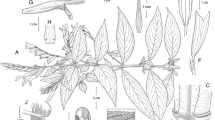Abstract
Salvia divinorum Epling & Mtiva-M. is one of the vision-inducing plants used in ritual curing by the Mazatec Indians of central Mexico. The present status of research is summarized. Experiments with material collected at different Oaxacan sites confirmed that the mint has white (rather than blue) flowers with a purple calyx and that flowering is induced by short day length.
Similar content being viewed by others
Literature Cited
Aguirre Beltrán, G. 1973. Medicina y mágia. Inst. Nac. Indigenista, Coleccion SEP/INI 1, México.
Alzate y Ramirez, A. 1772. El cáñamo, algunas costumbres de los indios. Gacetas de Literature de México 4:95–102. (Cited in Díaz 1979.)
Barabas, A., and M. Bartolomé. 1973. Hydraulic development and ethnocide: the Mazatec and Chinantec people of Oaxaca, Mexico. International Workers Group for Indigenous Affairs, Document 15. Copenhagen.
Benitez, F. 1973. Los Indios de México. Vol. III. 2nd ed. Ediciones Era, México.
Bickford, E. D., and S. Dunn. 1973. Lighting for plant growth. Kent State Univ. Press, Kent, OH.
Bourke, J. G. 1891. Scatalogical rites of all nations. Loudermilk, Washington, DC.
Brimblecombe, R. W., and A. L. Greene. 1962. Effect of monoamine oxidase inhibitors on the behavior of rats in Hall’s open field. Nature 194:983.
Cortés, J. 1979. La medicina traditional en la Sierra Mazateca. Actes du XLIIe Congrès, Paris: Societé des Américanistes 6:349–356.
Díaz, J. L. 1975. Etnofarmacología de algunos psicotópicos vegetales de México. In J. L. Díaz, ed., Etnofarmacología de plantas alucinógenas Latinoamericanas, p. 135–201. Cuadernos Científicos CEMEF 4, México.
—. 1979. Ethnopharmacology and taxonomy of Mexican psychodysleptic plants. J. Psychedelic Drugs 11:71–101.
Emboden, W. 1979. Narcotic plants. Rev. ed. Macmillan, New York.
Epling, C. 1939. A revision of Salvia, subgenus Calosphace. Repert. Spec. Nov. Regni Veg. Beih. 110:1–383.
—, and C. Játiva-M. 1962. A new species of Salvia from Mexico. Bot. Mus. Leafl. 20:75–76.
Espinosa, M. 1961. Apuntes históricos de las tribus Chinantecas, Mazatecas y Popolucas (1910). In H. F. Cline, ed., Papeles de la Chinantla III. Serie Científica, 7. Mus. Nac. Antropol., México.
Estrada, A. 1977. Vida de María Sabina. Siglo XXI, México (English: Estrada, A. 1981. Maria Sabina, her life and chants. Ros-Erickson, Santa Barbara, CA.).
Foster, S. 1984. Herbal bounty. Peregrine Smith Books, Salt Lake City, UT.
Heim, R., and R. G. Wasson. 1958. Les champignons hallucinogènes du Mexique. Edit. Mus. Nat. Hist. Paris.
Hofmann, A. 1964. Mexicanische Zauberdrogen und ihre Wirkstoffe. Pl. Med. 12:341–352.
—. 1980. LSD: my problem child. McGraw-Hill, New York.
Incháustegui, C. 1977. Relatos del mundo mágico Mazateco. Inst. Nac. Antropol. Hist., México.
Johnson, J. B. 1939. The elements of Mazatec witchcraft. Etnol. Stud. 9:128–150.
Munn, H. 1979. The mushrooms of language. In M. Harner, ed., Hallucinogens and shamanism, p. 86–122. Oxford Univ. Press, New York.
Ortega, A., J. F. Blount, and P. S. Marchant. 1982. Salvinorin, a new trans-neoclerodane diterpene from Salvia divinorum (Labiatae). J. Chem. Soc., Perkin Trans. I:2505–2508.
Reko, B. P. 1945. Mitobotánica Zapoteca. Private printing, Tacubaya, México.
Ryall, R. W. 1958. Effects of drugs on emotional behavior of rats. Nature 182:1606–1607.
Salisbury, F. B., and C. W. Ross. 1978. Plant physiology. 2nd ed. Wadsworth, Belmont, CA.
Savona, G., M. P. Paternostro, F. Piozzi, J. R. Hanson, P. B. Hitchcock, and S. A. Thomas. 1978. Salviarin, a new diterpenoid from Salvia splendens. J. Chem. Soc., Perkin Trans. I:643–646.
—, M. P. Paternostro, F. Piozzi, and S. A. Thomas. 1979. Splendidin, a new trans-clerodane from Salvia splendens. J. Chem. Soc., Perkin Trans. I:533–534.
Schultes, R. E. 1941a. Economic aspects of the flora of northeastern Oaxaca, Mexico. Ph.D. thesis, Harvard Univ., Cambridge, MA.
—. 1941b. A contribution to our knowledge of Rivea corymbosa, the narcotic ololiuqui of the Aztecs. Harvard Bot. Mus., Cambridge, MA.
—. 1976. Hallucinogenic plants. Golden Press, Western, New York.
—, and A. Hofmann. 1980. The botany and chemistry of hallucinogens. 2nd ed. Thomas, Springfield, IL.
Staba, E. J., and P. Laursen. 1966. Morning glory tissue cultures: growth and examination for indole alkaloids. J. Pharm. Sci. 55:1099–1101.
Taber, W. A., R. A. Heacock, and M. E. Mahon. 1963. Ergot-type alkaloids in vegetative tissue of Rivea corymbosa (L.) Hall.f. Phytochemistry 2:99–101.
Turner, R. A. 1965. Screening methods in pharmacology. Academic Press, New York.
Urbina, M. 1899. Peyotes. Datos para su estudio. Anales Inst. Med. Nac. México 4:203–214.
—. 1903. El peyote y el ololiuhqui. Anales Mus. Nac. México 7:25–48.
Valdés, L. J., III. 1983. The pharmacognosy of Salvia divinorum Epling & Játiva-M. Ph.D. thesis, Univ. Michigan, Ann Arbor, MI.
—, III, J. L. Díaz, and A. G. Paul. 1983. Ethnopharmacology of ska María Pastora (Salvia divinorum Epling and Játiva-M.). J. Ethnopharmacol. 7:287–312.
—, III, W. M. Butler, G. M. Hatfield, A. G. Paul, and M. A. Koreeda. 1984. Divinorin A, a psychotropic terpenoid, and divinorin B from the hallucinogenic Mexican mint Salvia divinorum. J. Org. Chem. 49:4716–4720.
Villa-Rojas, A. 1955. Los Mazatecos y el problema indígena de la cuenca del Papaloapan. Ediciones Inst. Nac. Indigenista, México.
Wasson, R. G. 1962. A new Mexican psychotropic drug from the mint family. Bot. Mus. Leafl. 20: 77–84.
—. 1963. Notes on the present status of Ololiuhqui and the other hallucinogens of Mexico. Bot. Mus. Leafl. 20:161–193.
—. 1980. The wondrous mushroom. McGraw-Hill, New York.
—, G. Cowan, F. Cowan, and W. Rhodes. 1974. Maria Sabina and her Mazatec mushroom velada. Harcourt Brace Jovanovich, New York.
Wasson, V. P., and R. G. Wasson. 1957. Mushrooms, Russia and history. Vol. II. Pantheon, New York.
Weitlaner, R. J. 1952. Curaciones Mazatecas. Anales Inst. Nac. Antropol. Hist. México 4:279–285.
—, and W. Hoppe. 1969. The Mazatec. In R. Wauchope, ed., Handbook of Middle American Indians. Vol. 7, p. 279–285. Univ. Texas Press, Austin, TX.
Author information
Authors and Affiliations
Rights and permissions
About this article
Cite this article
ValdÉs, L.J., Hatheld, G.M., Koreeda, M. et al. Studies ofSalvia divinorum (Lamiaceae), an Hallucinogenic mint from the Sierra Mazateca in Oaxaca, Central Mexico. Econ Bot 41, 283–291 (1987). https://doi.org/10.1007/BF02858975
Received:
Accepted:
Issue Date:
DOI: https://doi.org/10.1007/BF02858975




